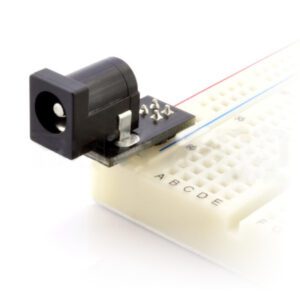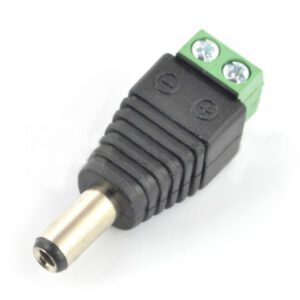Table of Contents:
Every device today needs a stable and reliable power source.
That’s why the DC connector has become a ubiquitous part of our electronic landscape.
From charging everyday equipment to powering professional systems, these inconspicuous components provide a crucial bridge between the power source and all sorts of devices.
We’ve put together a brief guide to the world of DC connectors.
Find out what you should know about them, how they work, what types of DC sockets and plugs we can find on the market, and where specifically these popular components are used.
Where did the DC connector come from?
The DC connector, which is one of the cornerstones of modern electronics, has a history that begins as early as the first decades of the 20th century, when electronics pioneers explored new ways to transfer power to evolving devices.
As the need for universal and easy-to-use connections became more apparent, DC connectors began to evolve from simple, handmade solutions to precisely designed components that revolutionized the way devices are powered.
This evolution has not only facilitated the development of new hardware, but has also defined standards that allow seamless integration of diverse technologies, becoming an indispensable element in almost every aspect of modern life.
What is a DC connector?
DC connector, consisting of a socket and a DC plug, is a component used to connect an electronic device to a DC power source.
Typically characterized by a cylindrical shape, it consists of at least two contacts: a positive (usually the center pin) and a negative (often the outer casing), providing a simple but reliable way to make a secure electrical connection.
It owes its versatility to its simplicity of design and ease of use, making it a widely used solution for a wide range of applications, from mobile device chargers to complex industrial power systems.
What types of DC connectors are available on the market?
On offer Botland store you will find different types of DC connectors, which you can adapt to many needs and applications.
Among the most classic solutions are DC connectors with a plug and socket, allowing you to simply and quickly connect devices to power supplies or other system components.
These traditional connectors are primarily characterized by their ease of use, as well as their versatility, making them a popular choice for many standard electronic applications.
They are available in many sizes and configurations, allowing them to be used in a wide range of devices, from, for example, audio/video equipment to various types of portable devices.
In addition to the classic variants, there are also available on the market DC connectors with quick-connectors, which offer even greater convenience and efficiency during installation. Quick disconnects allow tool-free connection of cables, which significantly speeds up the installation process and reduces the risk of mistakes.
They do not need to be soldered.
These types of connectors are particularly appreciated in applications where frequent changes in system configuration or rapid replacement of components are required.
Thanks to their convenience and reliability, DC connectors with quick connectors are used both in professional systems and DIY projects.
In the assortment Botland you have a choice of female, male and mixed DC connectors, allowing you to precisely match your specific application and system configuration.
Female and male models are dedicated to connecting to sockets or plugs, respectively, while mixed variants offer greater flexibility for building complex installations.
Each of these options also features specific dimensions and allowable operating voltages, which is crucial when designing safe, effective electronic connections.
With such a wide range, it’s easy to find the perfect DC connector to suit your needs and the specifications of a given project.
What is the DC connector used for?
DC connectors are an important part of the power supply for many electronic devices that require direct current to operate.
Their versatility and simplicity make them applicable to a wide range of solutions – from everyday use to advanced systems.
Here are some examples of where the DC connector is often found:
- Mobile devices – in tablets, laptops and other portable devices, the DC connector allows you to charge batteries and power equipment from external power sources.
- Peripherals – printers, scanners and other peripherals often use DC connectors to receive power from external power supplies or directly from computers.
- Uninterruptible power systems – UPS systems DC connectors are key to transferring power from batteries to protected equipment in the event of a power grid failure.
- Lighting – In LED lighting systems, the DC connector is often used to connect lighting modules to power supplies, allowing efficient energy management.
How to choose the right DC connector?
Choosing the right DC connector is a key element in designing reliable electronic systems.
When deciding on a particular type of socket and plug, consider a number of factors, such as maximum voltage and current, compatibility with the devices in which the DC connector is to be used, as well as specific operating conditions.
Equally important are the size and form of the connector, which must fit the design of the device.
A correctly selected model will allow you to safely power your chosen equipment.
How useful was this post?
Click on a star to rate it!
Average rating 4.6 / 5. Vote count: 11
No votes so far! Be the first to rate this post.





















